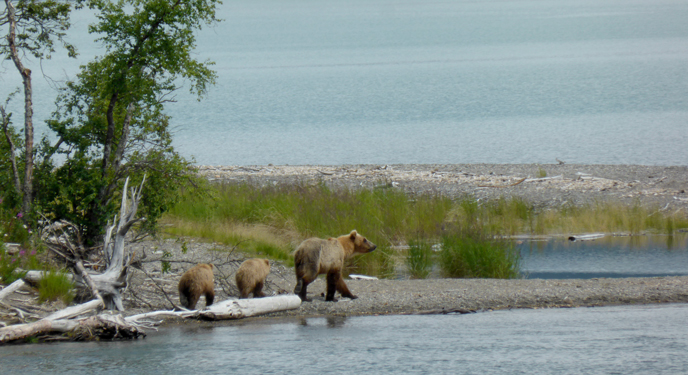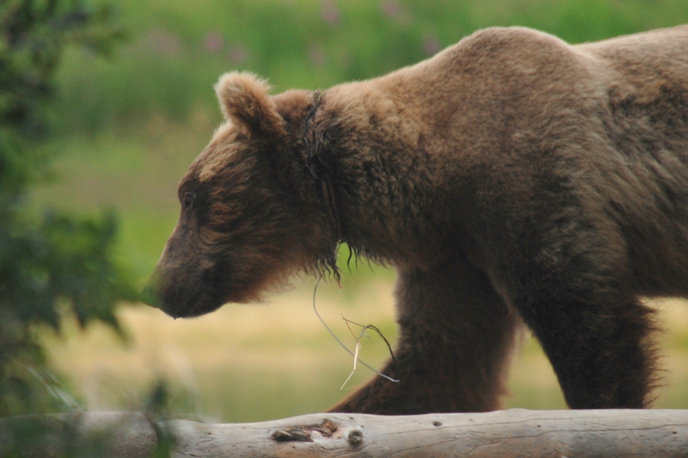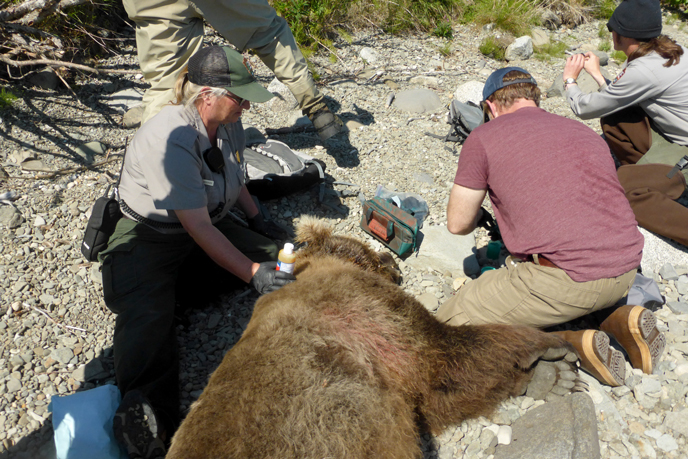About the Bear
854 Divot is a bear that was raised as a cub along the Brooks River. She was first classified as an independent 2.5 year-old bear in 2004 and is now 12 years old. She was a bear that rangers and many people who visited Brooks Camp got to know. For the first 8-9 years of her life, she was frequently seen fishing in the Brooks River, and even learned to recognize an easy meal and take fish from anglers who fished too close to her.
Over time, she was seen less frequently along the Brooks River and during the past two years, she was hardly seen at all. She was never known to have cubs, but in August 2013 she arrived along the Brooks River with two spring cubs. She returned on July 12th for a brief appearance with her two yearlings.

854 Divot and her two yearling cubs made an appearance at Brooks Camp on July 12, 2014. (NPS/M. Fitz)
On July 28, 2014, a bear with one yearling was reported walking along the beach at Brooks Camp. Being the bear-watching junkie that I am, I rushed outside to see the family. I immediately recognized Divot with one yearling cub. At the same time, I saw something wrapped around her neck. No bears in the Katmai region are currently radio-collared. Her necklace was something else, something that would likely be life threatening if left untreated. Upon closer inspection, the rangers and biologists at Brooks Camp were saddened to conclude that her necklace was probably a wire snare which was cutting slowly into her neck.

Bears are tough animals with a high tolerance for pain, but the snare around 854's neck would likely cause a fatal injury in time. (NPS/M. Saxton and B. Plog)
Few things, except changes in weather, happen quickly in bush Alaska. Tranquilizing bears and handling them is something Katmai’s staff almost never does. No bears have been tranquilized at Brooks Camp since the 1970s and no bear has been killed at Brooks Camp since 1983. With no staff certified to handle tranquilizing drugs or dart bears, we had to rely on outside help.
Calls were made to the US Fish and Wildlife Service and Alaska Department of Fish and Game offices in King Salmon, but their biologists were unable to assist. Luckily Grant Hilderbrand, a wildlife biologist for the National Park Service, was available. However, he lives in Anchorage and couldn’t get to Brooks Camp until mid-day on July 29.
We had the staff to assist Grant and he had the experience to tranquilize and handle the bear, but we didn’t know whether or not 854 Divot would appear again and give us the opportunity to tranquilize her and remove the snare. Katmai is a big place with much room for bears to roam. After all, most bears were finding fishing in the Brooks River too difficult. Consequently, almost all bears have moved to other streams to fish for salmon. As we awaited Grant’s arrival, our plan was to let 854 Divot come to us and track her if she moved away. We had no other choice. We had to get lucky.
Tracking the Bear
On the morning of July 29, she returned with her yearling near the NPS housing at Lake Brooks. She walked down the road from Lake Brooks toward the lower Brooks River. Eventually, she crossed the river and walked along the beach at Brooks Camp toward Dumpling Mountain.
If she disappeared into the forest on Dumpling Mountain, I had little hope that we’d ever find her again. The forest is thick and grass can be 4-5 feet high in open meadows in mid-summer. We’d be foolish to believe we could track her on the slopes of the mountain or even match her speed in such terrain.
Fortunately, Divot and yearling stuck to the shoreline along Dumpling Mountain. Even so, it was difficult for people to walk at a bear’s pace on Dumpling’s uneven shoreline. What we couldn’t do on foot, however, we could do in a boat. Staff jumped in a boat to watch her movements along the edge of Naknek Lake. After walking about 2 miles from Brooks Camp, she turned up a small creek on the side of Dumpling Mountain. By this time, Grant was on his way to Brooks Camp. If she came out of the forest, perhaps we’d have the opportunity we needed.
Taking a Shot
You won’t find Dumpling Creek on a map. It’s not an official name, but it’s the main drainage on the east side of Dumpling Mountain. Small numbers of salmon spawn in it. The creek is also a small and shallow stream, usually less than four feet wide so it is easy for bears to fish. If Divot found success fishing here, maybe she’d stick around.
By noon on July 29, there were two boats watching the shore near Dumpling Creek. Several members of the team, staying together, noisily ventured into the forest near the creek in the hopes that our noise would disturb the bear family enough that she’d appear on the beach. When that didn’t work, we were back to the waiting game.
Around 4 PM, just as we were about to leave and head back to camp, the bears appeared on the beach a few hundred feet from the creek. This looked like our opportunity. The boat with Grant and myself motored to shore along the bear’s line of travel, but she came too quickly and Grant was unable to get a shot. Within a few more seconds, she turned and walked up the creek and into the forest where it would be too difficult to find her.
854 and her yearling walked by our boat before we were set on July 29. (NPS/M. Fitz)
We all felt dejected. She came and went fast. Was that our one and only opportunity? She did not reappear that day.
Another Chance?The next morning, July 30, a boat with two staff members headed to Dumpling Creek to watch the shoreline. The rest of the NPS staff at Brooks Camp was watching to see if Divot would come back to camp. She didn’t arrive in Brooks Camp, but was spotted near Dumpling Creek again. We rushed out to that location to join the other crew, but by that time she was in the forest and couldn’t be seen. The waiting game began again.
Now we had two boats and many pairs of eyeballs watching the shore and forest for the bear. I felt relaxed, but not confident that she would reappear. Around 12:20 PM, 854 Divot and her yearling emerged from the forest several hundred yards from the outlet of Dumpling Creek and began walking toward us. This was our chance.
Grant directed the boat he was on to land on the shore, bow first, a couple of hundred yards between the bears and the creek. He wanted the tranquilizer’s effects to immobilize the bear before she got to the creek. With the boat sitting at the shore, Divot was still about 100 yards away. We were were confident that she would walk past us, since she seemed to be a human-habituated bear used to seeing planes, boats, and people near Brooks Camp.

On July 30, Grant was able to target 854 as she walked on the beach near Dumpling Creek. (NPS/M. Fitz)
Unlike yesterday, her pace allowed Grant to get set before she was too far away. As she continued toward the boat, we all sat quietly hoping to not alter her course. She continued to walk right towards us, and then—POW! Grant fired and the dart struck her shoulder.
Grant decided to target her shoulder instead of her rump in the hope that the tranquilizer’s effects would subdue the bear before she reached the small creek nearby and potentially drown. Of course, the large lake next to us was just as big of a concern, but the beach was the only place where we could see her. We were fortunate that she even appeared at all.
Divot viciously snapped at the dart after it hit her, but then started running down the beach with her yearling in tow. Within a hundred yards of getting struck, she began to wobble. First her hind legs lost mobility, then her front legs, then she collapsed on the beach.

854 collapsed on the beach not far from where she was shot with the tranquilizing dart. Her yearling cub stood by her side until the team of biologists and rangers approached. (NPS/M. Fitz)
Treating the Bear
After a couple of minutes, she was down for the count. She wouldn’t gain any mobility again for at least another hour and wouldn’t be able to walk normally for several more. We had time to work with, but we didn’t want to delay getting the snare off of her neck.
The snare had cut deeply into her neck and was very tight. It was like someone had scored her with a knife. Sherri Anderson, wildlife biologist for Katmai, cut the snare off with bolt cutters, while Grant directed the rest of the crew. After the snare was removed, we took hair and blood samples, applied a lip tattoo, and removed the dart. The wound around her neck was measured to be about an inch deep. It was treated with an iodine-like liquid called betadine to inhibit infection.

Biologists Sherri Anderson (left) and Grant Hilderbrand (right) worked quickly and efficiently to remove the snare around 854's neck. (NPS/M. Fitz)
Divot was still close to the water, too close in fact. When she began to move again she wouldn’t have full use of her limbs. She could fall in the lake and drown. Our last task was to move her off of the beach and into the grass to reduce that risk.
Have you ever tried to carry a bear? 854 Divot probably weighed about 400 lbs (182 kg), but moving her limp body was no easy chore. After much repositioning and repeated lifts, we succeeded in moving her off the beach and just into the grass where she would be less likely to tumble into the water.
As expected, the yearling cub was never far away. Sometimes, it was within 30 feet (9.1 m) of us. Typically, when a mother bear is tranquilized her cubs stay nearby. They may bawl and wander around closely, but don’t leave the area. That’s exactly what Divot’s yearling did. Within minutes of our departure, the yearling was at the side of its sedated mother.
Waiting for 854 to Awake
854 Divot was tranquilized around 12:25 PM and she would feel its effects at least for four more hours. After two hours, she was awake but still didn’t have much control over her limbs. We watched her carefully at this stage because there was still a risk of her drowning if she fell into the lake. We also stayed in the boats nearby to watch for other bears. If necessary, we would haze other bears away to prevent them from killing her as she was immobilized. After three hours, she was able to stand and let her cub nurse (the tranquilizer does not enter her milk). She then groggily walked to Dumpling Creek and laid down in it, perhaps to cool off.
By the fourth hour, she was still lethargic and hadn’t moved much. By this time, we felt confident that she could move if she wanted to as well as not drown in the lake. The wind on Naknek Lake was picking up and the small boat I was in doesn’t handle well in high winds so we reluctantly headed back to Brooks Camp. However, we were satisfied with our work for the day, which likely gave her a better chance of surviving what was likely a fatal injury caused by the snare.

As 854 began to recover, she crawled down to the beach where she remained until she regain the full use of her legs a few hours later. The green smudge on her muzzle is dye from the application of her lip tattoo. (NPS/M. Fitz)
854 Divot and her yearling have been seen several times since she was tranquilized and treated. Most sightings have been near Dumpling Creek, which contains spawning salmon. She was having fishing success there before she was tranquilized, so it would make sense that she would stay nearby.
On Saturday, August 2, 854 Divot and her yearling cub made an appearance along the banks of the lower Brooks River. Both bears seemed energetic and playful. I don’t know what the future will hold for this bear and her yearling, but I feel confident we rectified a mistake by removing the snare and gave this bear family the best chance of survival.
A video about the effort to help this bear, including footage of the tranquilizing and handling of the bear can be found at this link: http://youtu.be/n7sbqfgw8VI.
